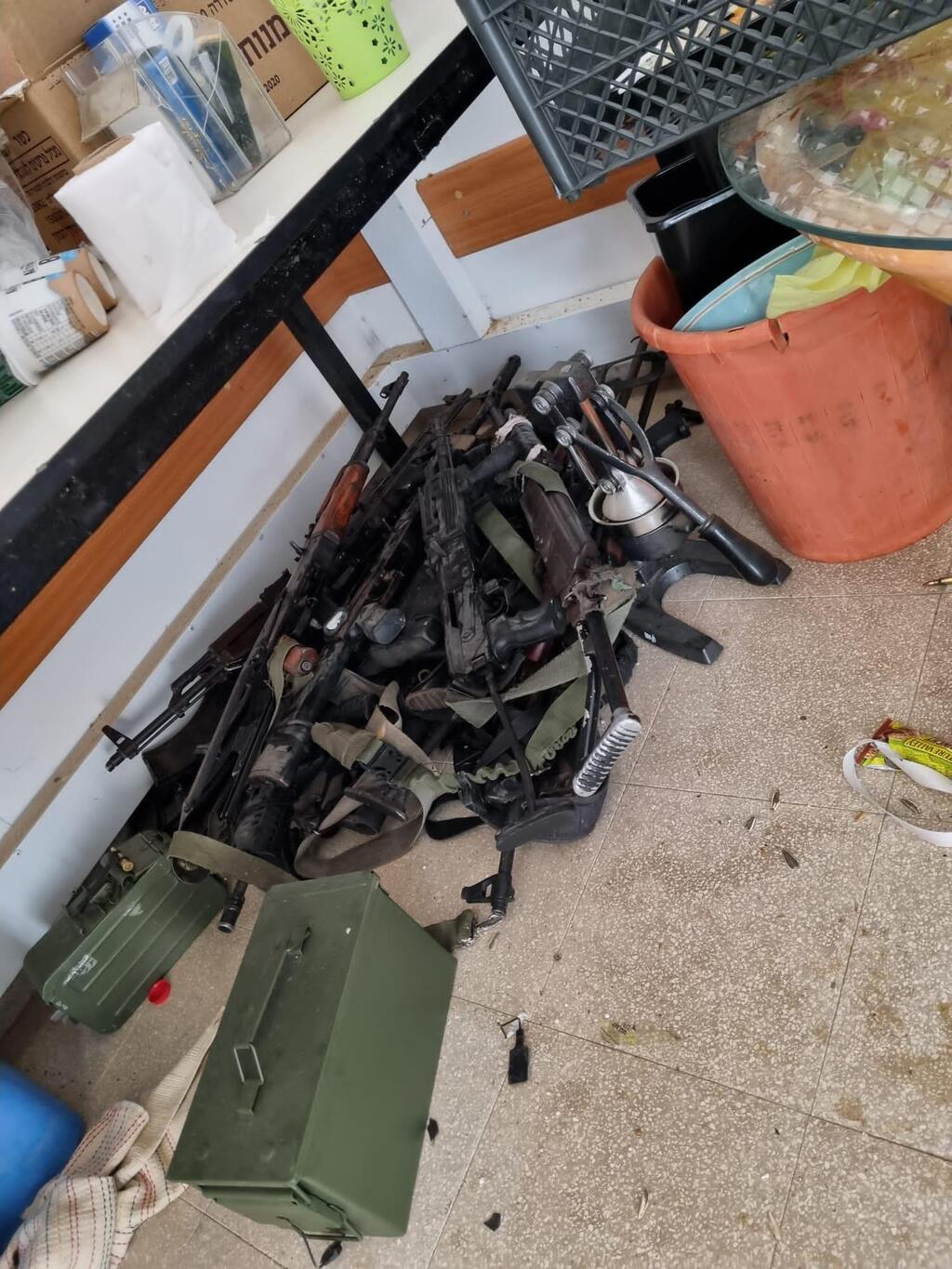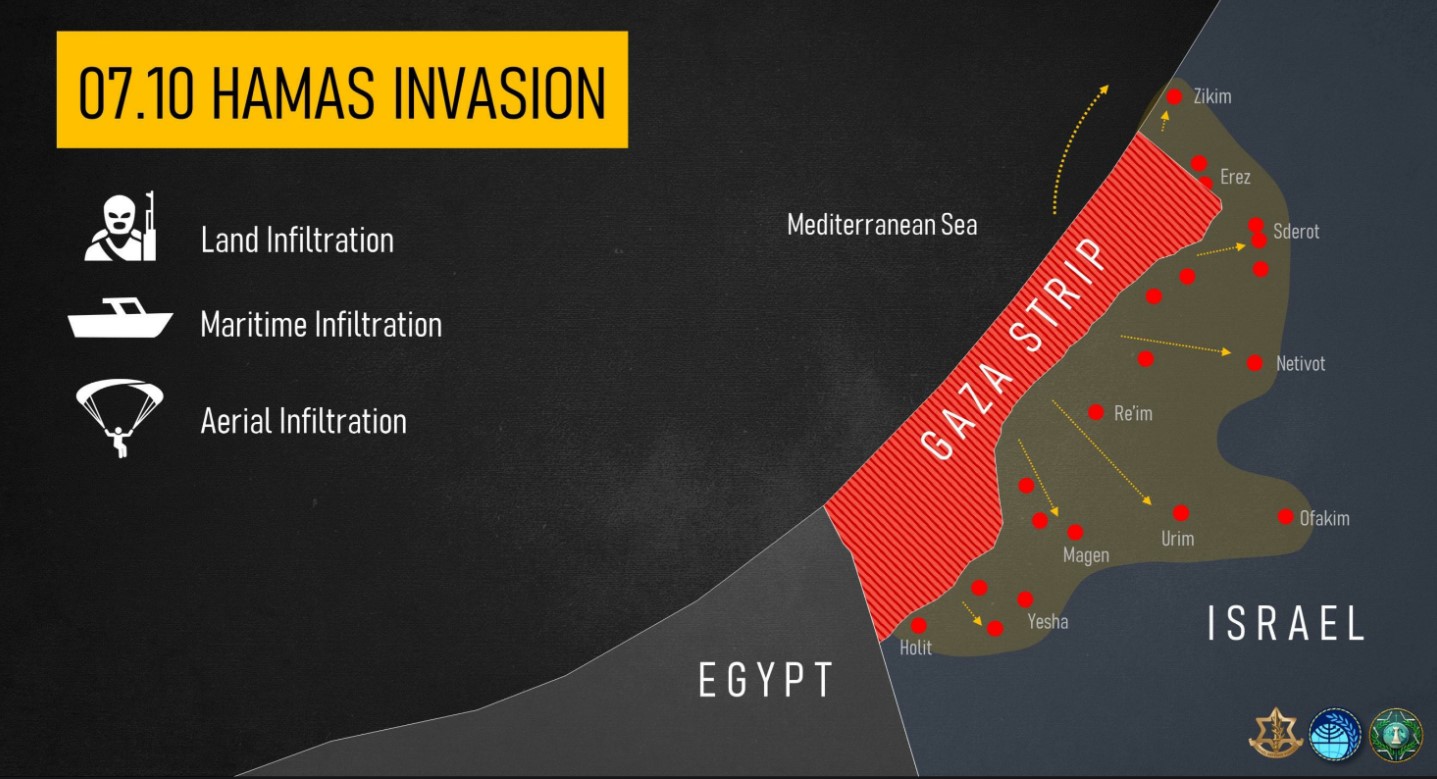The Israel-Hamas War: Operation Iron Sword
The Massacre
(October 7, 2023 - Present)
By Mitchell Bard
Attack By Sea
The Nova Festival
Kfar Azza
Sderot
Kibbutz Be’eri
Ofakim
Nir Oz and Other Communities
The IDF’s Slow Response
The invasion began at 6:00 a.m. with Hamas terrorists attacking from land, sea, and air, accompanied by a massive missile bombardment that, by the end of the day, exceeded 4,000 rockets. The degree of coordination was striking, and senior Hamas official Ali Baraka revealed planning for the attack took two years.
As in the past, the Iron Dome intercepted a high proportion of projectiles, but the system is not capable of intercepting every rocket, and some reached as far as Tel Aviv and Jerusalem, though most landed in the communities nearest Gaza and along the coast up to Ashkelon.
Israel began retaliatory airstrikes around 5 p.m. on October 7. In the first two days, more than 2,600 targets were struck, including attack tunnels, rocket launching sites, command and control centers, and terrorist infrastructure.
Attack By Sea
Hamas naval forces infiltrated Israel. The Israeli Navy killed dozens of terrorists. The Shayetet 13 commando unit captured the deputy commander of the southern division of the Hamas naval force, Muhammad Abu Ghali.
Shayetet 13 commandos were also airlifted to the Gaza border, where they fought and killed more than 60 terrorists, captured 26, and rescued 250 hostages. Two members of the unit were killed.
The Nova Festival
One of the first encounters occurred in a forest about three miles from the border. Thousands of young people, most Israelis, but also foreigners who had come for a peace festival, were attacked by hundreds of terrorists. At least 260 revelers were gunned down, an unknown number were taken hostage, some escaped, and others remain unaccounted for.
In a widely circulated video, a man is seen being marched toward Gaza with his arms held behind his back while his terrified girlfriend is being driven away on a motorcycle. Cars were riddled with bullets, and another video showed a person who appeared dead being shot. — on the ground by a car but moving — being shot by a man with a rifle and then lying still. Ano
Kfar Azza
This is where some of the worst atrocities occurred. The gruesome scene of corpses piled in a tent, with reports that one or more women may have been raped and that bodies had been defiled, shocked and infuriated the nation. The discovery of 40 dead babies, some with their heads decapitated, was a horror beyond imagination.
Sderot
Pickup trucks filled with terrorists rode into the city, and everyone in their path was shot. At one bus stop, seven civilians were found dead. The police station was overrun. Altogether, at least 20 civilians were killed, as well as about a dozen soldiers, firefighters, and police officers.
Kibbutz Be’eri
At 6 a.m. on October 7, two terrorists were seen on security cameras trying to enter the kibbutz. More gunmen arrived later and began going house to house, killing the occupants. Some houses were set on fire to draw out the inhabitants so they could be shot. When Israeli troops finally came to free the inhabitants trapped in their homes, they found burnt cars and houses, and bodies lined up on the street.
Roughly 1,000 people lived in the kibbutz, and more than 130 bodies were discovered after it was liberated. Security forces killed 103 terrorists.
Ofakim
A city of 40,000, Ofakim came under attack when two trucks arrived with 14 terrorists. According to the Times of Israel, “Only spontaneous action on the part of residents and police officers, armed with knives, a few handguns, and eventually the terrorists’ rifles, stopped the act, but not before the city lost about 50 people within five hours.”
Mayor Itzik Danino told TOI, “Spontaneously, residents started to organize. Some came out with flip-flops and knives. They didn’t understand the level of threat posed by the terrorists.”
In one of the remarkable stories from that fateful day, five terrorists broke into the home of Rachel Edry. Over the next 15 hours, she conversed and served them treats before security forces arrived and killed the terrorists.
Nir Oz and Other Communities
 |
The battle in Kibbutz Nir Oz lasted about eight hours. One resident, Lotus Lahav, told the New York Times, “We realized that it’s only about half of the people here.” She said about 350 to 400 people were there when the attack started, and only about 200 were left when it was over.
A retired nurse who went to the kibbutz to help recover the bodies said some were burned beyond recognition.
In one of many tales of heroism, the Times of Israel said, “a handful of men and women who, with only two rifles and a few handguns, prevented a detachment of heavily armed terrorists from setting foot in their community of Ein Habesor.”
In the same story, TOI said Inbal Rabin-Lieberman, the 25-year-old security coordinator of Kibbutz Nir Am, and her uncle killed two terrorists and effectively deterred an attack on their kibbutz.
Yet another example of bravery involved Noam Tibon. His son, Amir, a journalist for Haaretz, was sheltering with his wife and two daughters when terrorists infiltrated Kibbutz Nahal Oz. Amir called his father to tell him they were under attack. Noam, a reserves general, drove from Tel Aviv and met up with soldiers who killed the intruders and rescued his son.
Youssef Ziadna, an Arab Bedouin, drove a group of Israelis to the music festival on October 7. At 6 a.m., he received a call for help from one of them. He went back to the area, where he saw a man and a woman who tried to get him to turn around. He got out of the bus, and the three came under fire. He returned to the bus and continued to the area of the party where terrorists were shooting concertgoers. He managed to round up 30 people and raced away under gunfire. The bus reached safety at a nearby kibbutz. Ziadan later learned one of his cousins was murdered, and four members of his family were missing. Recounting the events, Ziadna explained why he didn’t turn away from danger. "I said no way, I will throw myself at death if it means I can save lives."
In addition to the atrocities, it was reported that terrorists stole credit cards from their victims. “Due to the security situation, we have seen cases where credit cards and bank account information are being misused,” the Bank of Israel said in a statement. “These situations have been dealt with since the outset by professionals at the Bank of Israel.”
To further torture the Israeli public, Hamas broadcast videos of their handiwork, showing naked women, captured children, and beheaded soldiers. They also disseminated videos of the taking of hostages, such as an elderly woman driven away in a golf cart and Palestinian children tormenting a young Israeli boy.
The IDF’s Slow Response
Former intelligence officer Yossi Alpher said, “It took troops more than half a day to enter the kibbutzim and the town of Sderot. The army completely failed as a quick-reaction force. The kibbutzim have emergency civilian units that went into action straight away, and heroically, but at a huge cost in losses as they were outnumbered by terrorists. For more than a day, the IDF spokesperson and the government were incapable of updating the public.”
Alpher acknowledged the situation was exacerbated by the fact that the attack occurred on Shabbat when many Jews were at synagogues and had their phones turned off. By 8 a.m., he said observant Israelis had learned there was a serious security incident.
Though many people who were trapped were under siege for hours, some troops did engage the terrorists. One tank commander said that he drove through the towns targeted by Hamas and said his crew killed more than 70 terrorists. In another location, an anti-terror unit fought 20 terrorists with cover from an all-female tank crew, which then engaged with other terrorists. “We cleared out all the terrorists and brought them out. I lost track of time. I only know that the women fought like lionesses,” said one of the fighters.
In another battle, six officers and a new recruit were killed, preventing Hamas from overrunning the Zikim training base. They saved 90 new recruits and likely many more Israelis who would have been targeted if the terrorists had advanced to other locations in Israel. Those who fell were Second Lt. Yannai Kaminka, 20; Captain Adir Abudi, 23; First Lt. Or Moses, 20; Sergeant Eden Alon Levy, 19; Private Neria Aaron Nagari, 18, and Second Lt. Adar Ben Simon, 20.
On March 17, 2024, the Knesset voted unanimously to annually mark the massacre as a national day of remembrance on the Hebrew date of the 24th of Tishrei rather than October 7 on the Gregorian calendar.



